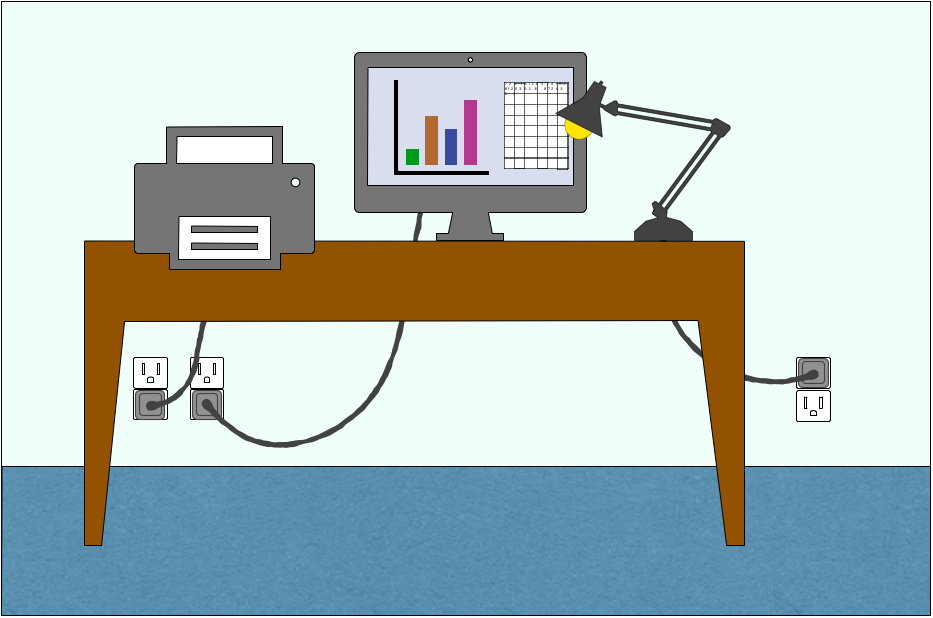In an office, one of the easiest and most cost-effective areas to implement sustainable practices are employee workstations. Below is an example of an inefficient workstation. Compare it to the desks at your office. What problems do you notice? Continue reading to review several of the problems with the desk in the picture below and learn about potential solutions to these problems that can decrease energy waste, increase workplace efficiency, and reduce cybersecurity risks. Keep in mind that although many of these solutions are relatively simple, when you administer these changes across an office, the positive impacts multiply so that you should see a noticeable reduction in your energy bill.

Problem 1: Server rack under the desk.
Servers that are not housed in specialized server storage rooms or data centers pose several threats to an office. For one, many of these servers are stored in unmonitored rooms that people can access without an individual access key. This greatly increases the risk for physical cyberattacks. Additionally, such servers usually do not have a back-up battery or computer-safe fire suppression system and so, in the case of a power outage or fire, data collection and access may be permanently damaged. Finally, servers that are stored in rooms that are not retrofitted with a cooling system optimized for server storage cannot be cooled efficiently and so they will generate an unnecessary spike in the office's electricity bill.
Suggested Solution: In order to increase security, reliability, and energy efficiency, move all servers to a specialized server storage room or data center. If your company or institution does not have one of these, is unable to build one, or does not have enough servers to justify retrofitting your own data closet, consider leasing space from a nearby data center or using a cloud-based data storage service. To learn more about data centers see the data center overview and data center efficiency pages.

Problem 2: Individual printer at the desk.
Individual peripherals such as printers, copiers, fax machines, and coffee machines consume more energy than common shared appliances. They also may reduce employee interaction and workplace collaboration because people with individual peripherals need to leave their desk and interact with the office less often.
Suggested Solution: Rather than individual employees using their own peripheral devices, consolidate these devices to a few shared appliances in common spaces in the office. This should reduce energy consumption and increase collaboration between employees.

Problem 3: Monitor and lamp turned on when no one is at the desk.
According to the National Renewable Energy Laboratory, although most workstations are occupied for less than a quarter of the year, most people leave their devices on all of them time, which means that some office plug-loads are used as little as 10% of the year. Leaving appliances on when they are not being used not only wastes electricity, leaving a computer on when it is not being monitored by its owner makes the computer accessible to everyone who passes by, resulting in the data becoming considerably more vulnerable to cybersecurity attacks and data theft. When no one is using a device, it is best to turn the device either to sleep or off. However, this can be inconvenient for employees who are just leaving for a couple of minutes and hard to remember at the end of a long work day. Fortunately, there is an easy solution.
Suggested Solution: To prevent a computer monitor from staying on during significant bouts of inactivity, optimize computer power settings to balance security, sustainability, and efficiency. If you have an office wide computer system control, it might be most efficient to administer specific computer settings. Learn more about UVA facilities management's computer power optimization study on the Workstation Power Management project page. Additionally, in order to reduce the energy waste from other vampire IT in your workstation, use a smart power strip so that devices will turn off after a period of inactivity.

Problem 4: The technological equipment is not the most efficient option.
Even with conservative power settings and a smart power strip, the energy output of the devices in this office space are not optimized. Do you need the lamp? If so, make sure the lamp and all of the other lights in the office have fluorescent bulbs. Is the desktop computer the most efficient device for that employee? Perhaps he or she would be just as or more productive with a laptop or tablet. Generally, these devices use less energy than desktops.
Suggested Solution: Making sure that every employee has the most efficient device that supports all of their needs is called right-sizing and it can take a lot of individual time and evaluations. However, when it is time for an employee to replace their old machine, determine what they are using their device for and if another, more efficient type of IT equipment could suit their needs.

For more information on right-sizing and other green workplace practices, read the Green Use page.
